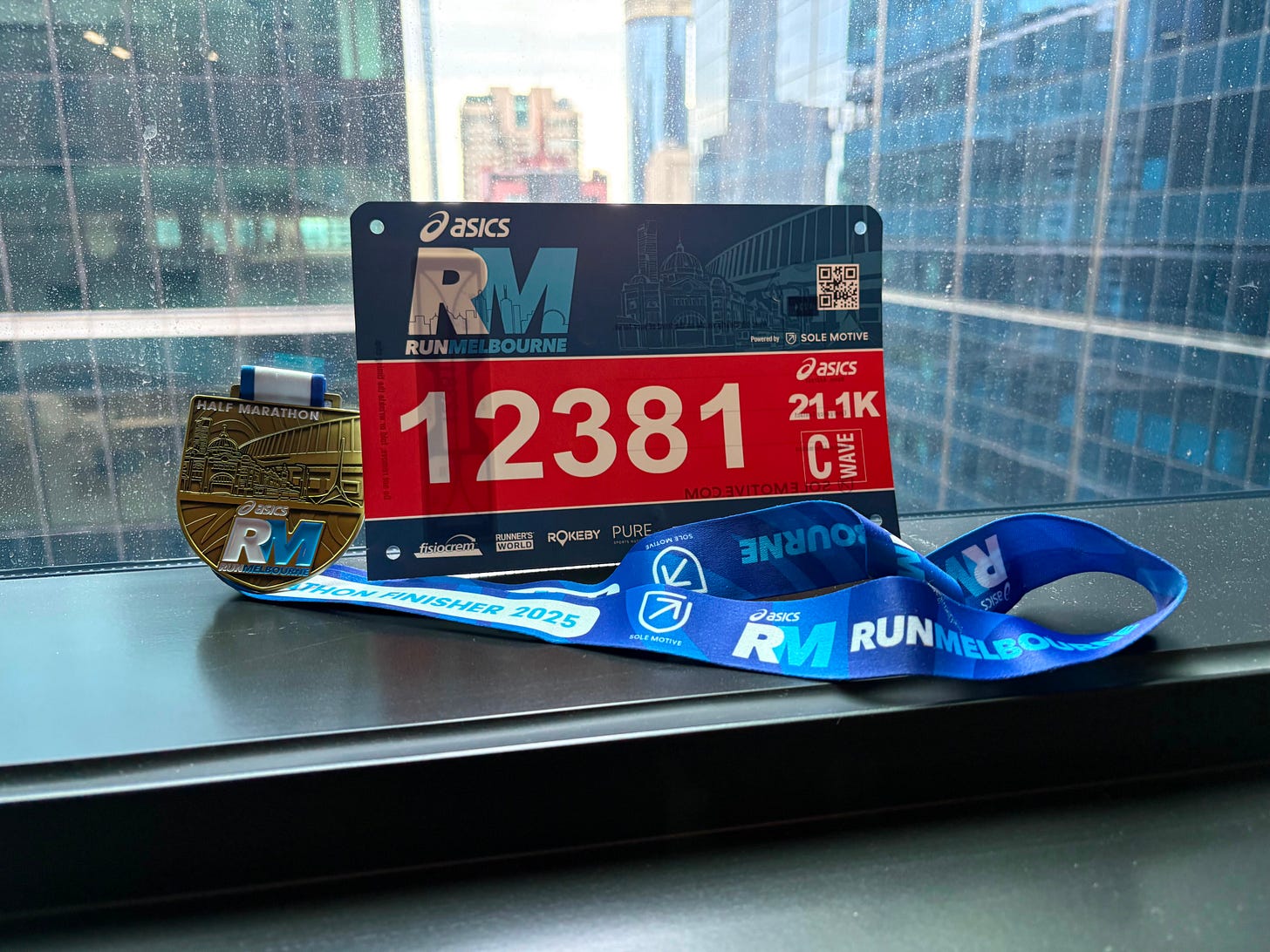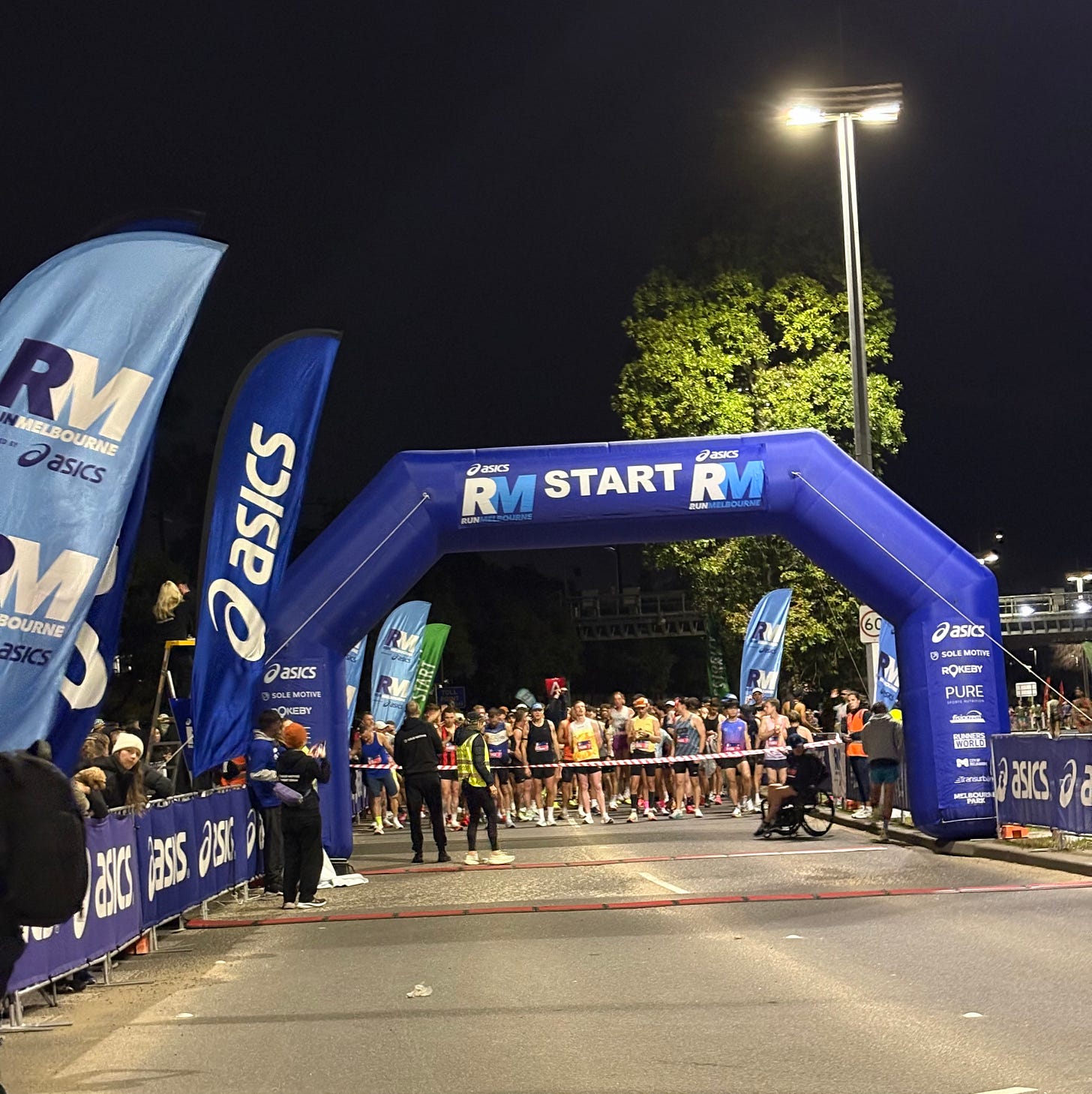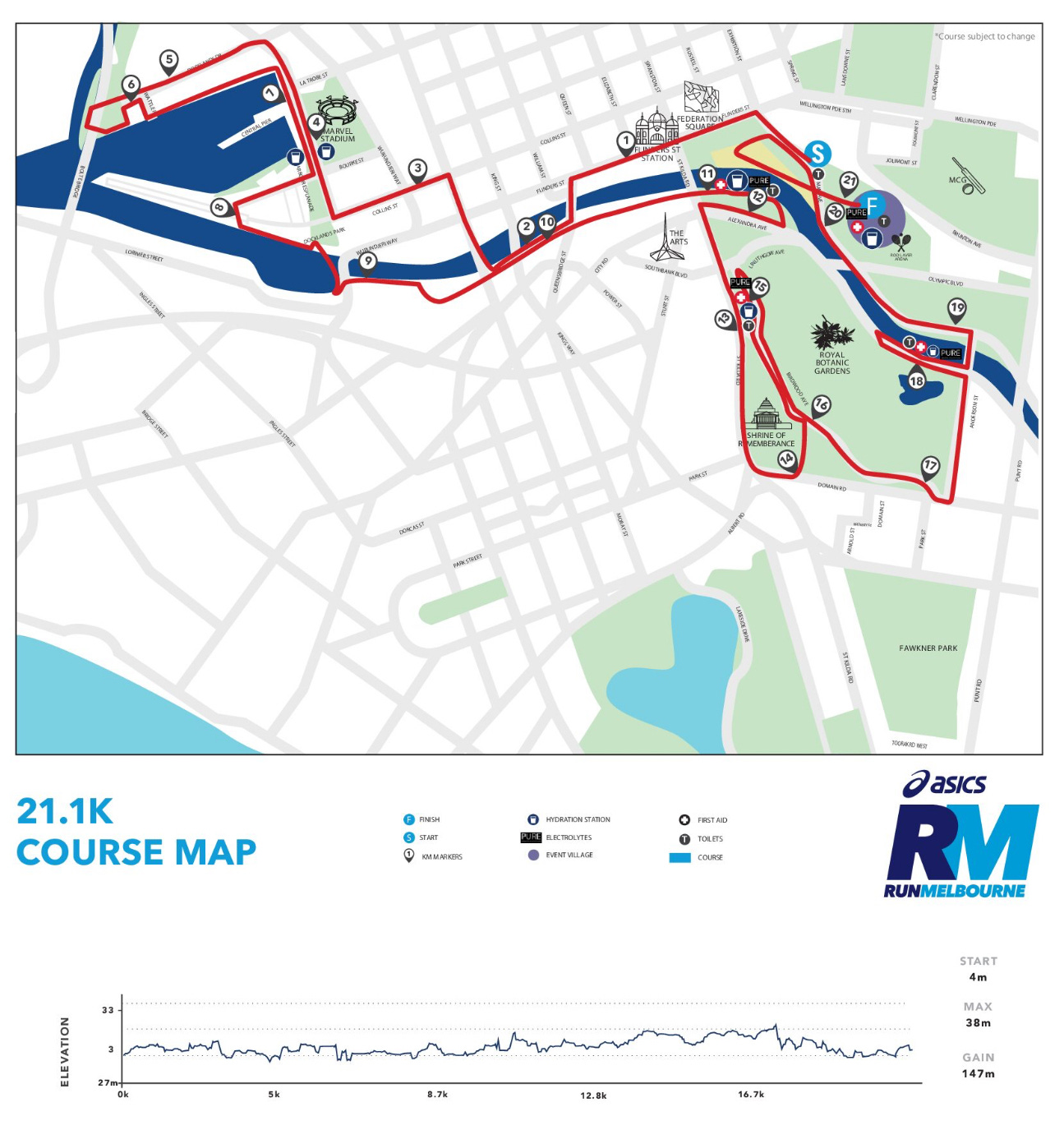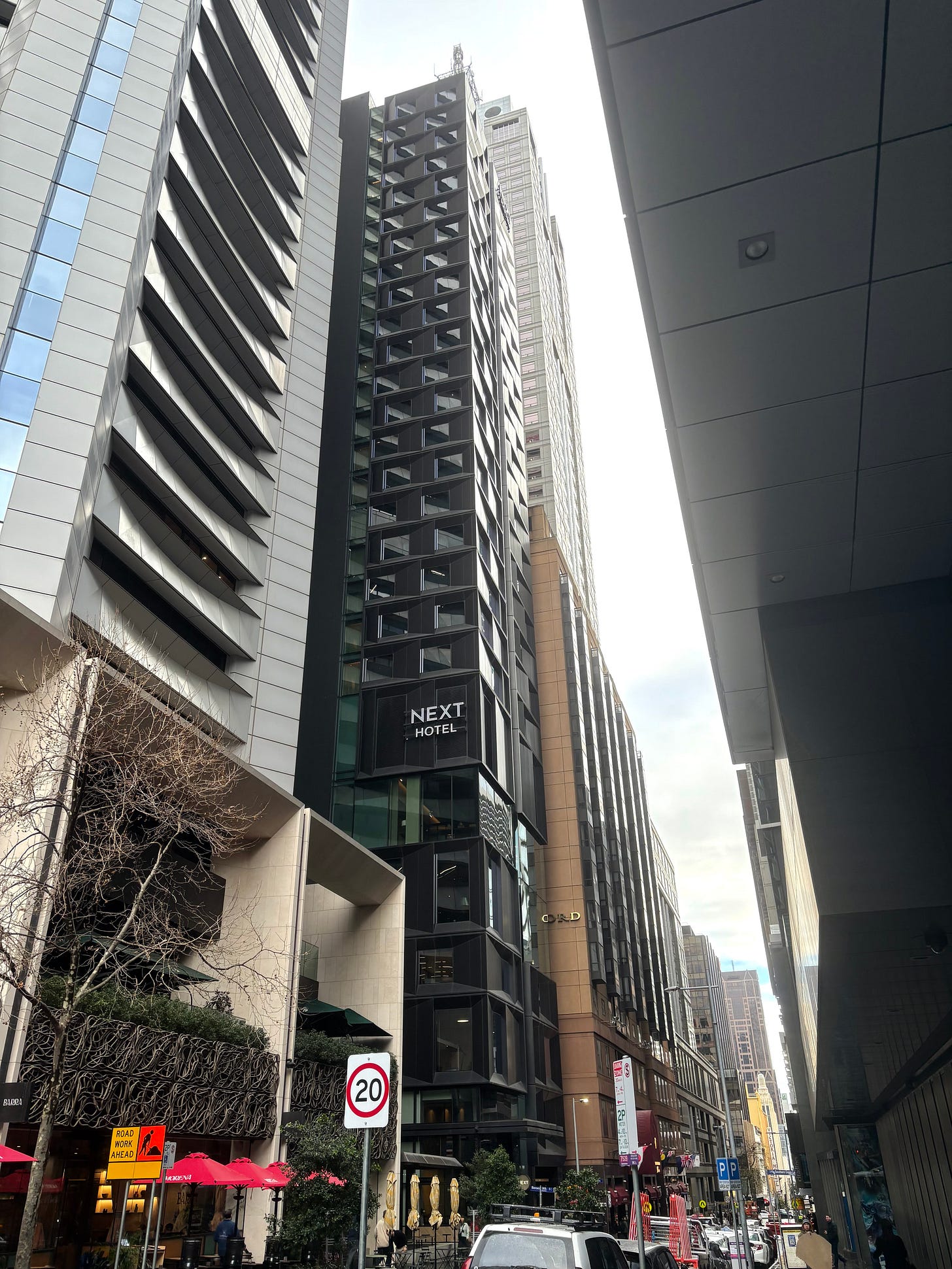Run Melbourne Half Marathon 2025 review & trip report
Plus: Things to like about Australia’s second largest but sometimes overlooked city. Australian immigration annoyances. Travel and non-rev notes.
Birds — at least, those into long-haul flying — migrate to warmer temperatures. Runners — at least, those into it as well — migrate the opposite way. My “summer” running calendar this year had me heading from Southern California to the Southern Hemisphere winter twice. The first trip was to Melbourne, Australia. (Not to be confused with the one in Florida.) The second to Buenos Aires. This post is about the first. (I’m writing much of it on the Buenos Aires trip some weeks later — my post on that will follow.)
Melbourne perspectives
People often think of Australia in terms of the great outdoors. But it is actually among the most urbanized countries in the world, in terms of where the population is located as a proportion of the landmass. Or maybe suburbanized, as the larger cities spread far around their centers. Melbourne — with a population of around 5.5 million — is the second-largest city in Australia. It is a great and very agreeable city. But it is often left off the itinerary of visitors to the country who focus on more familiar circuits taking in Sydney, Cairns, and Uluru (a.k.a., Ayer’s Rock), with maybe Brisbane added in too.
I’d been to Melbourne once many years ago on business. And I’ve been to Sydney a couple of times (or three if you include a stay of under eight hours), most recently a couple of years ago for the Hoka Runaway Half. I don’t claim to know either city very well, but there is a view out there preferring Melbourne to Sydney. It’s the same sort of vibe that makes some people prefer Osaka to Tokyo, Munich to Berlin, or Cape Town to Johannesburg. A second-greater-than-the-first outlook.
Melbourne is on the southern tip of Australia. And speaking of Cape Town comparisons, I’d place Melbourne along with that city — and also Vancouver — in a “great city on the edge” category. Those three great cities — all with a British imperial past — are literally on the edges or corners of continents, the last staging posts in their hemispheres before voyagers would head off into oceanic wilderness and Arctic or Antarctic environs. Arguably Buenos Aires also falls in that category (albeit without the British past). I have visited all four of those cities this year, so there is a bit of a theme to my travels, although I didn’t plan that in advance.
Central Melbourne is very walkable. Much of it is in a grid layout, similar to North American cities, but a local hallmark is that the broader streets going longways on the rectangle are paralleled by narrower ones with the same name but the word “Little” appended. For example, Collins Street is paralleled by Little Collins Street, Bourke Street by Little Bourke Street, etc. From my exploration, the Little streets tended to be the more interesting thoroughfares fares than their bigger siblings.
But what I particularly liked about parts of central Melbourne were the narrow alleys and arcades connecting some of the longer parallel streets. The narrow passageways — sometimes called “laneways” — don’t generally accommodate vehicles and are often bustling with life, including cafes, bars, and small shops and restaurants. They go back to Victorian times. The arcades are the ones that are covered.
On the afternoon of my arrival, I researched and walked an itinerary taking in some of the best of the alleys and arcades. And I returned to one of the alleys for my pre-race pasta dinner the next day and to one of the arcades for a post-race beer after running the half marathon.
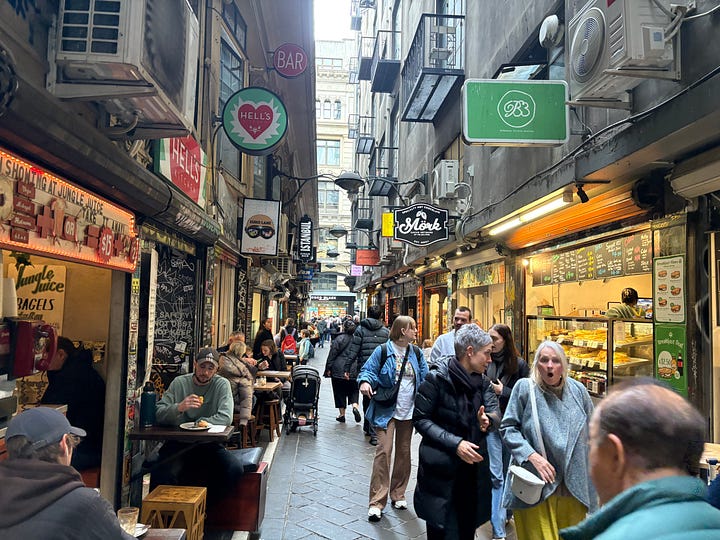
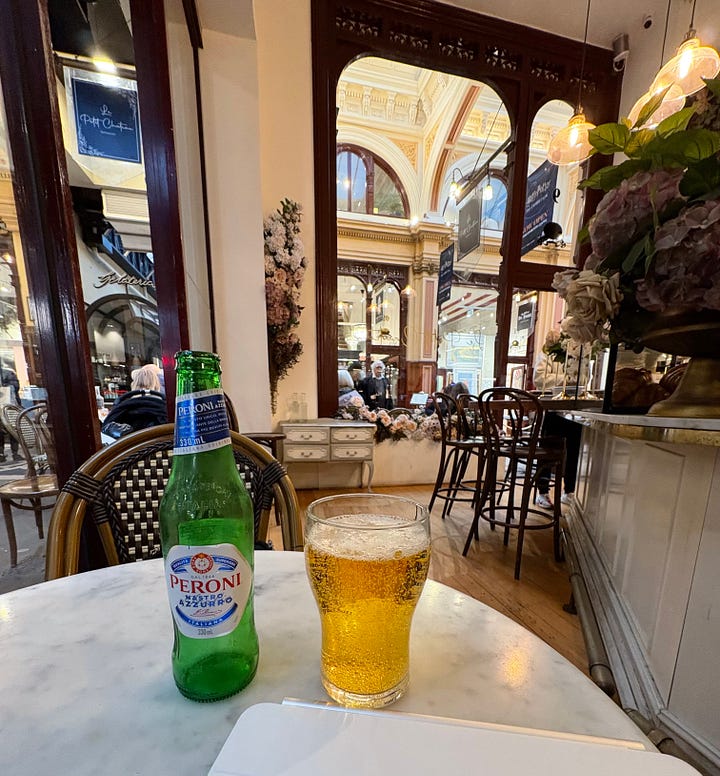
Melbourne ranks high on lists of the world’s most livable cities. Public transport seems plentiful, including out to the suburbs, and the city is easy on the eye. But there are no globally iconic sights or activities to draw visitors. And that, perhaps, is a reason why it can be overlooked. That and the fact that it’s in the opposite direction from Sydney compared with the most popular Australian destinations. Nonetheless, you can fly there nonstop from the U.S. More on that later.
Run Melbourne review
Run Melbourne is one of two major half marathons that takes place every year in Melbourne. It is held in July, comfortably into the winter season. It involves a half marathon and a 10K as well as a 5.5K (an unusual distance). Run Melbourne is organized by Sole Motive, a local and long-established running retailer. It is sponsored by ASICS, the Japanese sportswear company. It’s quite a large event. The 2025 results showed around 11,200 runners in the half.
The other event, the Nike-sponsored Melbourne Marathon Festival in October, has both a full and a half as well as a 5K and 10K. All other things being equal, I prefer half marathons where the half is the longest event. While the half in half/full combo events tends to attract more runners, it nonetheless seems more “half” when there is also a full taking place at the same time.
Compared with some races, Run Melbourne doesn’t sell out far ahead of the event (at least, not in 2025). But it does sell out, so you don’t want to leave it too late. I registered in early May and paid US$102, which is pretty reasonable by today’s standards (I recently paid about double that for a place in Miami on the day registration opened). Like the last race I ran in Australia — the one in Sydney — Run Melbourne is not swag-heavy. A shirt isn’t included in the race entry. And they don’t heavily promote merch as an upsell. If you do buy one of the ASICS race shirts, be advised they run small (something I’ve noticed with ASICS shirts before).
There isn’t a pre-race expo. Instead, runners are directed to one of Sole Motive’s stores in Melbourne to pick up their bib during the weekdays leading up to the race. If you leave it to the Saturday before the race, there’s a pickup tent in the race finish area.
The race begins at 6:30 a.m. on the Sunday. That’s before dawn in Melbourne at that time of year. The changing light contributes to the variety of the course. And it is a varied course overall, taking in — among other things — major city center streets, a waterfront area, and a botanical park. There are splendid views of the city’s skyline along the way. Running this race is a great way to see the city in a big-picture way — sort of like being on a hop-on-hop-off bus tour, except that you’re just hopping along on your feet all the way. The course is for the most part a big loop with the finish close to where you start. You don’t spend much time running back along segments you’d done in the other direction. It is pretty flat overall, although there are some gentle and fairly short hills — I noticed them more toward the end. The weather was perfect for running — dry and crisp, without being too cold.
The race start was one of the least crowded I’ve known. This may have been because I positioned myself at the back of my wave and was a bit late entering the corral. Course support along the way was about average. But there was quite a lot of encouragement from bands and crowds in the last mile or so. I thought the water stations could have been better organized — they were just a little small for runners to pick up a cup without slowing down too much.
Course inaccuracy?
It’s a fantastic course, without doubt. But I did have some concern as to whether the distance was a bit off. My dual-band GPS watch clocked 12.86 miles, almost a quarter of a mile short of 13.1. While watches can give inaccurate measurements, variances tend to report distances a bit longer than the official lengths (because of inefficiencies in how runners follow the course). Moreover, dual-band GPS generally eliminates problems caused by tall buildings as it doesn’t require continuous line of sight to deliver accurate results. And I did notice some posts online by other runners reporting the same, including one that quoted the race organizers as apparently acknowledging an issue. What’s more, I also found that there had been reports of inaccurate measurements in at least one previous year. I reached out to Sole Motive for comment, but didn’t hear back. So I’m not sure whether or not this was a known actual issue.
Another possibility when runners encounter an incorrect distance is that they ended up inadvertently taking a wrong turn at a certain point in the course. I don’t think that’s what happened with me, although there was a point a few miles in where the precise course seemed a bit vague and I just followed the herd. But it’s hard to see how that could have made a quarter-mile difference even if something was a bit off.
Being a metrics-oriented runner, the distance issue bothered me. But I suppose some might consider it a bonus if it gave them a better time.
My recorded time was 2 hours 16 minutes. If the course was short, that would probably equate to closer to a 2 hour 20 minute time. That would still be my best since heart issues impacted my running in 2024, although it’s at least a minute per mile slower than where I was before.
Travel notes
I was in Melbourne for three nights, getting there early on the Friday morning before the Sunday race and leaving on the Monday morning after it. I stayed in a Hilton property called Next Hotel that’s part of its Curio collection of boutiquey hotels. It’s a modern hotel on Little Collins Street, an agreeable half-hour walk from the station where the airport bus dropped me off. (Other than the bus from and back to the airport, I relied on my feet entirely for getting around in Melbourne.)
I choose the hotel for its location — it was an easy walk to the race start/finish. But it was a good pick in its own right. I paid under $150 night — booking through the ID90 portal for airline staff and their close ones — and the hotel readily gave me an early check-in at around 9:45 a.m. as well as access to their lounge, where they served free breakfasts and a free happy hour in the evening.
I think it might have helped that I recently acquired Gold status in the Hilton Honors program, a perk of my newly acquired Amex Platinum Card (which also catapulted me into an elevated status with Marriott). The breakfast spread was impressive — the sort for which you’d normally expect to pay at least US$30. And the happy hour — which actually lasted two hours — came with oysters and a fairly elaborate charcuterie spread in addition to the full bar. One could, in theory, survive in Melbourne quite well on the Next lounge food alone — although I ate a couple of pasta dinners while carb loading during the two days before the race as well as some sushi.
United and Qantas both fly nonstop to Melbourne from Los Angeles and San Francisco. Qantas also flies there from Dallas and Honolulu. I believe American has flown to Melbourne in the past. There are no nonstop flights from Europe.
Traveling standby, I was able to snag United Polaris Business Class from Los Angeles to Melbourne and had a great flight. The arrival experience at Melbourne was less satisfactory (no fault of United). I’m not sure whether it is often like that, but the immigration process when I landed was a mess with vast crowds of people coming off different international flights trying to funnel into an overcrowded arrival system — bodies pressed against each other like on a crowded subway — and people seeming not to have much of a clue as to whether they were waiting in the right place. I figured a way through the system, but suspect that most took much longer than me. (Hint: Go/do where/what most other people aren’t going/doing. That goes for a number of things in life.)
Before you even fly to Australia, you need to get one of those electronic travel authorizations that, while technically not a visa, amounts to the same thing. You do this on an app on your phone and, in theory, it should only take a couple of minutes. The problem is that you may encounter a problem with the app taking the required photo. It must have taken me about 100 attempts spanning over two days before it finally took mine. At times, I began to think I just wouldn’t be able to go to Melbourne. Sometimes you think it is working, but you then get a message rejecting the photo. But my problem wasn’t over when I finally got it to work. When I then answered a question stating I was a dual national, it wanted to take the photo again for some reason. Eventually I obtained my clearance, but my advice is not to leave this to the last minute.
Others have reported similar experiences in forums like Reddit. The problem seems to exist only on iPhones, not Android devices. But there is no clear pattern as to why some people encounter it and others don’t. I tried all manner of settings, lighting conditions, and backgrounds. When it finally worked, I wasn’t doing anything different from what I had tried numerous times before. Hopefully the app will improve (and, to be fair, I had no problems with my 2023 trip to Sydney).
Surprisingly, after all of this, United didn’t even want to check to see if I had obtained the authorization when I departed the USA. But maybe their system connected with the Australian immigration one to match the clearance to my passport number.
Non-rev notes — Qantas and United
Non-revving is a bit like my day job (law and alternative dispute resolution), as you always learn new things. I didn’t fly in either direction on Qantas, but learned a few things about non-revving on them as I positioned myself to do so. The first is that when you list for a flight determines your place on the standby list within your priority level, not when you check in. I’d never previously known of an airline that does this.
The second is that Qantas premium loads change a lot in the last 24 hours. I believe that’s because they run an auction system trying to encourage revenue passengers to pay for last-minute upgrades. So what might seem like a very promising Business Class non-rev scenario can change quickly and fundamentally. Nonetheless, I did get offered Premium Economy for the outbound. But it was a middle seat — and I rolled the dice hoping for Business on United and won.
I was very impressed with the Qantas app, incidentally. It gives staff travelers a lot of information on which to make informed decisions. It is not quite in the same league as the United app — the best in class worldwide — but it is significantly better than most.
On the way back from Melbourne, it was a bit different. The United and Qantas flights to California were scheduled to go out within an hour or so of each other. I’d planned on taking Qantas in this direction with the hope of getting Business on the A380 but prepared to be happy with whatever I got. However, Qantas was facing a long delay — six hours plus. I was afraid it would cancel. An A380 from Sydney had cancelled the day before. So I took United and ended up in the back of the plane — still a decent flight, with an empty seat next to me. I’d already checked in on Qantas and tried to cancel once I knew I’d be taking United, but the system wouldn’t let me — I think because it was too close to the original scheduled departure time even though it was hours from the actual one.
In the end, the Qantas flight didn’t cancel. So when I was airborne over the Pacific in United Economy and connected to WiFi (free, courtesy of T- Mobile), I started getting tantalizing seat assignments from Qantas once its flight was closer to its heavily delayed boarding. First, it was an aisle in Premium Economy. But then an hour or so later, I had been moved to Business — and, what’s more, to the holy grail for solo non-rev travelers, an upper-deck window. So in that case, the Qantas trend was the opposite of on my outbound — the loads got better. That may have been a function of some revenue passengers finding other flights because of the delay.
My Qantas ZED fare was, like all non-rev tickets, refundable. But I nonetheless don’t like being a no-show on a non-rev ticket, even though I couldn’t avoid it on this occasion. Still, this vignette evidences the truth of the non-rev wisdom that you don’t know what the final outcome is until the plane pushes back. Which, in this case, was after I was in the friendly skies.
The other thing I learned on this trip is that United will refund me the difference if I list for Business standby but end up being seated in Economy. Not all airlines do that. The United policy was always a bit unclear to me, and it may differ depending on which airline you or your loved one works for. Also, the refund process is different from that for unused — as opposed to downgraded — listings. But it does remove part of the stress of standing by for a premium seat. You don’t get a refund if you list for Business and get seated in Premium Economy, however. So if you prefer an aisle or window in the back to a middle in Premium (as do I), you need to get officially downgraded after being “upgraded,” rather than just switch seats once on board — or the system won’t record where you ended up sitting. Maybe they won’t refund, however, if it was a voluntary downgrade. I haven’t tried that out.
No matter which airline you non-rev on out of Australia, don’t expect to be given a pass to standby at the gate itself. You need to be confirmed before you go through security — regardless of what the airline’s normal policies are. If your flight is pretty open, you may — depending on the airline — get a confirmed seat assignment when you present yourself at the check-in desk a couple of hours or more ahead of departure. But don’t count on it. So be prepared for the dash to the gate after revenue check-in closes and no or minimal lounge time.
Run Melbourne Half Marathon conclusion
For: Great course. Against: Questionable course distance accuracy. Sum-up: Tempting choice globally for a July race, and a no-brainer if you live close by. ✈️ 🏃
If you’ve stumbled across this post, please consider subscribing to this blog using the button below. It covers the intersection of running, travel, and aviation, and includes race reviews from around the world. Subscribing costs nothing — and never will — but supports the site. You’ll get an email every month or two with new posts.
For a list of other recent posts, click here.

